
Dagens Nyheter, abbreviated DN, is a daily newspaper in Sweden. It is published in Stockholm and aspires to full national and international coverage.

In architecture, functionalism is the principle that buildings should be designed based solely on their purpose and function.
The year 1930 in architecture involved some significant events.

Kungsholmen is an island in Lake Mälaren in Sweden, part of central Stockholm, Sweden. It is situated north of Riddarfjärden and considered part of the historical province Uppland. Its area is 3.9 km2 (1.5 sq mi) with a perimeter of 8.9 km (5.5 mi). The highest point is at Stadshagsplan at 47 metres (154 ft). The total population is 71,542.
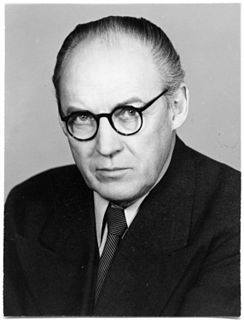
Sigurd Lewerentz was a Swedish architect.

Gert Wingårdh is a Swedish architect whose company, Wingårdh arkitektkontor, maintains an international practice.

Sven Gottfrid Markelius was a Swedish modernist architect. Markelius played an important role in the post-war urban planning of Stockholm, for example in the creation of the model suburbs of Vällingby (1950s) and Farsta (1960s).

The Dagens Nyheter Tower, called DN-Skrapan (DN-Skyscraper) in Sweden, is an office building in the Kungsholmen district of Stockholm, Sweden. It is eighty four metres (276 ft.) tall and has 27 floors, none of which are underground. It was completed in 1964 and was designed by architect Paul Hedqvist.

Skatteskrapan is a 26-storey, 86 m (282 ft) building in Stockholm, Sweden. It is located at Götgatan 76 in the district of Södermalm, in a block named Gamen. With an initial height of 81 metres and 25 floors, it was the tallest building in Sweden from its completion in 1959 to 1964 when it was surpassed by the 84 metres tall Dagens Nyheter Tower.
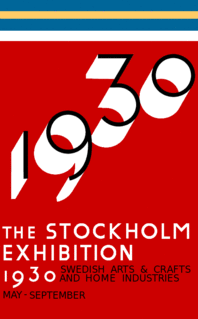
The Stockholm Exhibition was an exhibition held in 1930 in Stockholm, Sweden, that had a great impact on the architectural styles known as Functionalism and International Style.
Tranebergsbron is a double arch bridge in central Stockholm, Sweden. Stretching over the strait Tranebergssund it connects the major island Kungsholmen to the western suburb Bromma. It carries a road and metro tracks.

The Maritime Museum in Stockholm, Sweden is a museum for naval history, merchant shipping and shipbuilding. Located in the Gärdet section of the inner-city district Östermalm, the museum offers a panoramic view of the bay Djurgårdsbrunnsviken. The building was designed by architect Ragnar Östberg and built in 1933–36.

Barnhusviken is a body of water in central Stockholm, Sweden. Separating the island Kungsholmen from the mainland district Norrmalm north of it, it connects Karlbergssjön to Klara Sjö.

Lill-Janskogen,, is a park in Stockholm, Sweden.

Södra Ängby is a residential area blending functionalism with garden city ideals, located in western Stockholm, Sweden, forming part of the Bromma borough.
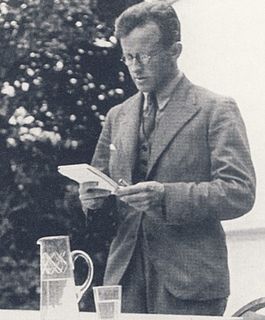
Uno Åhrén was a Swedish architect and city planner, and a leading proponent of functionalism in Sweden.
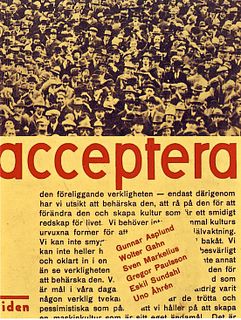
acceptera (1931) is a Swedish modern architecture manifesto written by architects Gunnar Asplund, Wolter Gahn, Sven Markelius, Eskil Sundahl, Uno Åhrén, and art historian Gregor Paulsson. Claiming that Swedish “building-art” (byggnadskonst) has failed to keep pace with the revolutionary social and technological change sweeping Europe in the early 20th century, the authors argue that the production of housing and consumer goods must embrace a functionalist orientation in order to meet the particular cultural and material needs of both modern society and the modern individual. Combining social analysis with an iconoclastic critique of contemporary architecture and handicraft, acceptera ardently calls upon its readers not to shrink back from modernity, but rather to “accept the reality that exists—only in that way have we any prospect of mastering it, taking it in hand, and altering it to create a culture that offers an adaptable tool for life.”
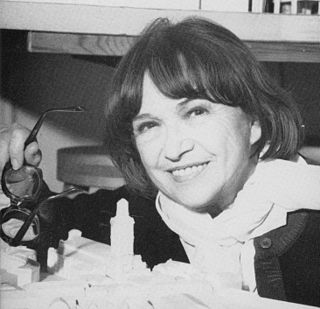
Léonie Geisendorf, née Kaplan, was a Polish-born, Swedish architect. She lived most of her professional life in Stockholm, Sweden. At the time of her death, she was living in Paris, France.

Jarl Algot Gustav Törneman, nicknamed P. was a Swedish enamel artist and painter.






















